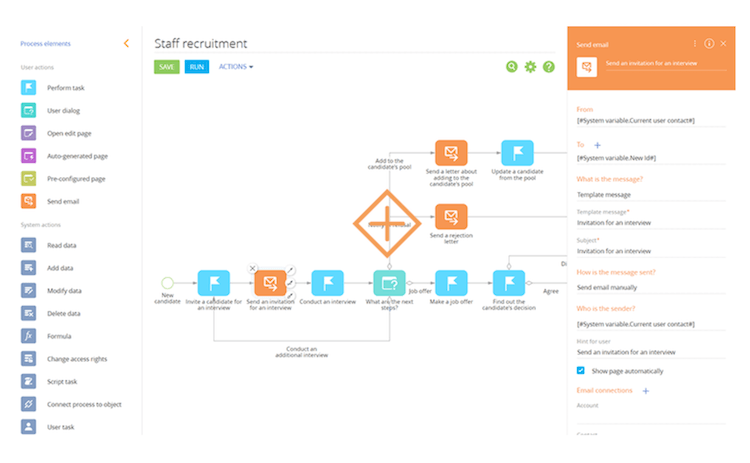
The term digital transformation has become a buzzword for numerous industries. As pioneering enterprises continue to see expectations from employees and customers shifting towards more digital and mobile experiences, it’s more important than ever that businesses begin transforming their operations to become increasingly digital and agile to maintain a competitive advantage.
As a result, more organizations are focusing on developing custom software and mobile app solutions, but are finding that they often lack the resources needed to effectively execute the planning and development of a mobile product in-house. The truth of the matter is that traditional software and app development methods require an entirely different set of skills than web development or other traditional IT systems. This is where low-code/no-code platforms come into play.
Major support to digital transformation within a business, low-code/no-code development platforms can make software and app development up to 10 times faster than traditional methods. These platforms allow what Gartner refers to as “citizen developers” within an organization to design and build applications that can scale without having to write any code.
This post will take an in-depth look into these two platforms, their benefits, and why they have become so popular.
What is low-code development?
Low-code development refers to the development of software, applications or databases through a graphical user interface (GUI). Because low-code development requires the use of a visual integrated development environment (IDE), the amount of programming knowledge one needs is minimal. The user simply uses visual components to assemble their custom application. Where low-code differs from no-code is the option to view and edit source code. This is where some prior coding knowledge is helpful and offers greater customizability.
What is no-code development?
No-code development requires no previous coding knowledge and offers no possibility of viewing or editing the source code. Using a GUI (an example is shown below) users can use no-code development platforms by dragging and dropping features straight into their application framework. These features can generally be released and used immediately.
Source: BPM Online Studio
Advantages of Low-Code/No-Code Platforms
Faster development: Where traditional app development can take several months, the same product can be built within a few days or weeks using low-code/no-code platforms. Faster development means that products can be released to market quicker and more frequently. Additionally, updates can also be made more frequently as anyone can make changes regardless of their level of coding knowledge, ultimately meaning users get the product quicker.
Cross-platform compatibility: Most custom applications developed through traditional methods are typically built for one platform or another, either Android or iOS for example. This restriction is largely due to the costs associated with developing for two very different platforms. However, low-code/no-code development applications are cross-platform and can be deployed for use across multiple devices.
Higher productivity: Because developers don’t need to spend extended hours writing complex lines of code, developers now have more time to focus on other outstanding tasks.
Use the talent you have: Low-code/no-code development platforms don’t require businesses to have specially trained developers familiar with different programming languages. In most cases basic HTML knowledge is more than enough, allowing businesses to utilize IT professionals within their organization to execute their development solutions.
Why low-code/no-code platforms are popular
Low-code/no-code platforms have become so popular that Forrester suggests that the increased interest in low-code platforms alone is driving approximately 50 percent annual growth, with the market anticipated to rise to over $15 billion in 2021.
Source: Forrester
So what has made these platforms more favorable than traditional development methods? A large part of that popularity can be attributed to enterprises’ increased investment into digital transformation and becoming agile organizations. Low-code/no-code development platforms virtually eliminate the need for manual coding, speeding up the entire process. This results in the ability to update software more frequently and efficiently giving organizations a considerable competitive advantage.
Because the agile methodology is centered around short and frequent releases, the accelerated development process offered by low-code/no-code development plays directly into this aspect of the methodology and ensures that technology will not be a barrier that holds back an organization. With low-code/no-code platforms, individuals or small teams can experiment, prototype, and deliver apps within days or weeks.
Furthermore, these platforms help enterprises cut unwanted costs that can arise during development by simply eliminating the need to hire specially trained programmers and developers. Because very minimal knowledge of coding is required, any staff member can develop and update apps and software.
Is This the End of Coding
Are low-code/no-code platforms the end of coding? Not exactly. There will always be specific requirements that enterprises will want in their customized software or app, and this will always require manual coding. With low-code/no-code development, developers chose elements from a broad range of preset templates, tying everything together with minimal amounts of code or none at all. While this speeds up the development process, this type of development is unlikely to fulfill all of the needs enterprises require for their specific software or app development projects. To get the best of both worlds it’s best for enterprises to use low-code/no-code platforms in conjunction with some element of manual coding to allow for maximum customizability.
To gain more insight into mobile app development trends and enterprise mobility visit the Clearbridge Mobile blog.













